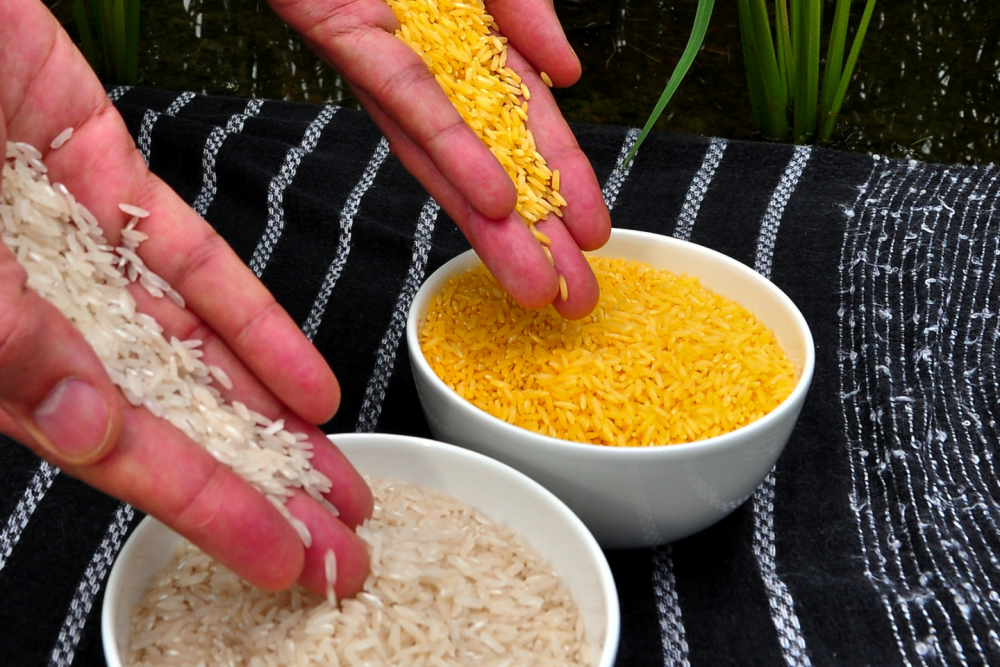
In this standards-aligned, 5-E lesson plan, students will learn about the development of Golden Rice, a genetically-engineered organism, as a way to combat vitamin A deficiency (VAD) in developing countries.
Estimated Time
Two, 50-minute class periods
Student Learning Targets
Students will read a text to learn about the issue of vitamin A deficiency.
Students will research two potential solutions to address the issue of vitamin A deficiency- vitamin A drops and genetically engineered rice known as Golden Rice.
Students will evaluate solutions based on criteria (cost, safety, reliability, and aesthetics/perception) to make a recommendation for which solution (or combination of solutions) would best address the issue.
Key STEM Ideas
Genetic engineering solutions can be applied to solve real-world issues such as combating micronutrient deficiencies. Evaluation of safety, cost, reliability, and aesthetics or perception of a solution is an essential process prior to adoption of a particular solution.
Students' Prior Knowledge
Students should have a basic understanding of the need for micronutrients (vitamins and minerals) for proper development and survival. This lesson would provide a good example of how genetic engineering is used in a real world context prior to or following students learning more about the specifics of how they are designed and created.
Connections to FEWSS
In order to consume the nutrients, vitamins, and minerals needed for survival and proper development, humans eat a diversity of foods. In some developing nations, access to many different types of food is limited. In these countries, cereals such as wheat, rice, or corn are staple foods meaning they are regularly eaten and provide the majority of the calories necessary for survival.
Rice is a staple food for over 3 billion people, representing the major carbohydrate and protein source in Southeast Asia and Africa. Unfortunately, rice is a poor source of many essential micronutrients (vitamins and minerals). Therefore, a rice-based diet is the primary cause of micronutrient deficiencies throughout much of the developing world. Iron, zinc, and vitamin A deficiencies are common in rice-consuming regions. These deficiencies account for decreased work productivity, reduced mental capacity, stunting, blindness, increased child mortality, and elevated morbidity and mortality in general.
These micronutrient deficiencies affect particularly children, impairing their immune system and normal development, causing disease and ultimately death. The best way to avoid micronutrient deficiencies is by way of a varied diet, rich in vegetables, fruits and animal products. However, other solutions may be implemented to improve the nutritional health in developing nations.
Golden Rice was invented by Ingo Potrykus, a retired Swiss professor, and Professor Peter Beyer of the University of Freiburg, Germany as a solution to vitamin A deficiency. The rice was genetically engineered to produce and accumulate a carotenoid, beta-carotene, in the edible part of the grain (the endosperm). Beta-carotene is often called pro-vitamin A and is transformed into vitamin A by the body. Transforming the rice to include the genes for beta-carotene, is an economical way to provide relief from vitamin A deficiency (VAD).
Curriculum ConnectionsNext Generation Science Standards
- HS-ETS1-1. Analyze a major global challenge to specify qualitative and quantitative criteria and constraints for solutions that account for societal needs and wants.
- HS-ETS1-3. Evaluate a solution to a complex real-world problem based on prioritized criteria and trade-offs that account for a range of constraints, including cost, safety, reliability, and aesthetics as well as possible social, cultural, and environmental impacts.
Common Core Standards
- CCSS.ELA-Literacy.RST.9-10.9 Compare and contrast findings presented in a text to those from other sources (including their own experiments), noting when the findings support or contradict previous explanations or accounts.
- Student Resources (Word Doc) (389.47 KB)
- Student Resources (PDF) (332.91 KB)
- Teacher Resources (Word Doc) (396.13 KB)
- Teacher Resources (PDF) (399.94 KB)